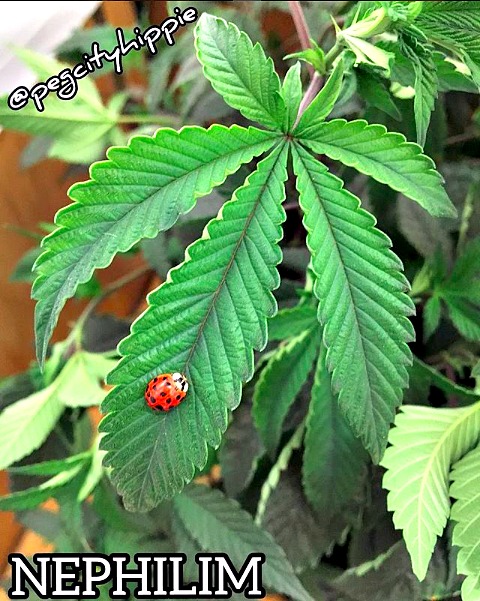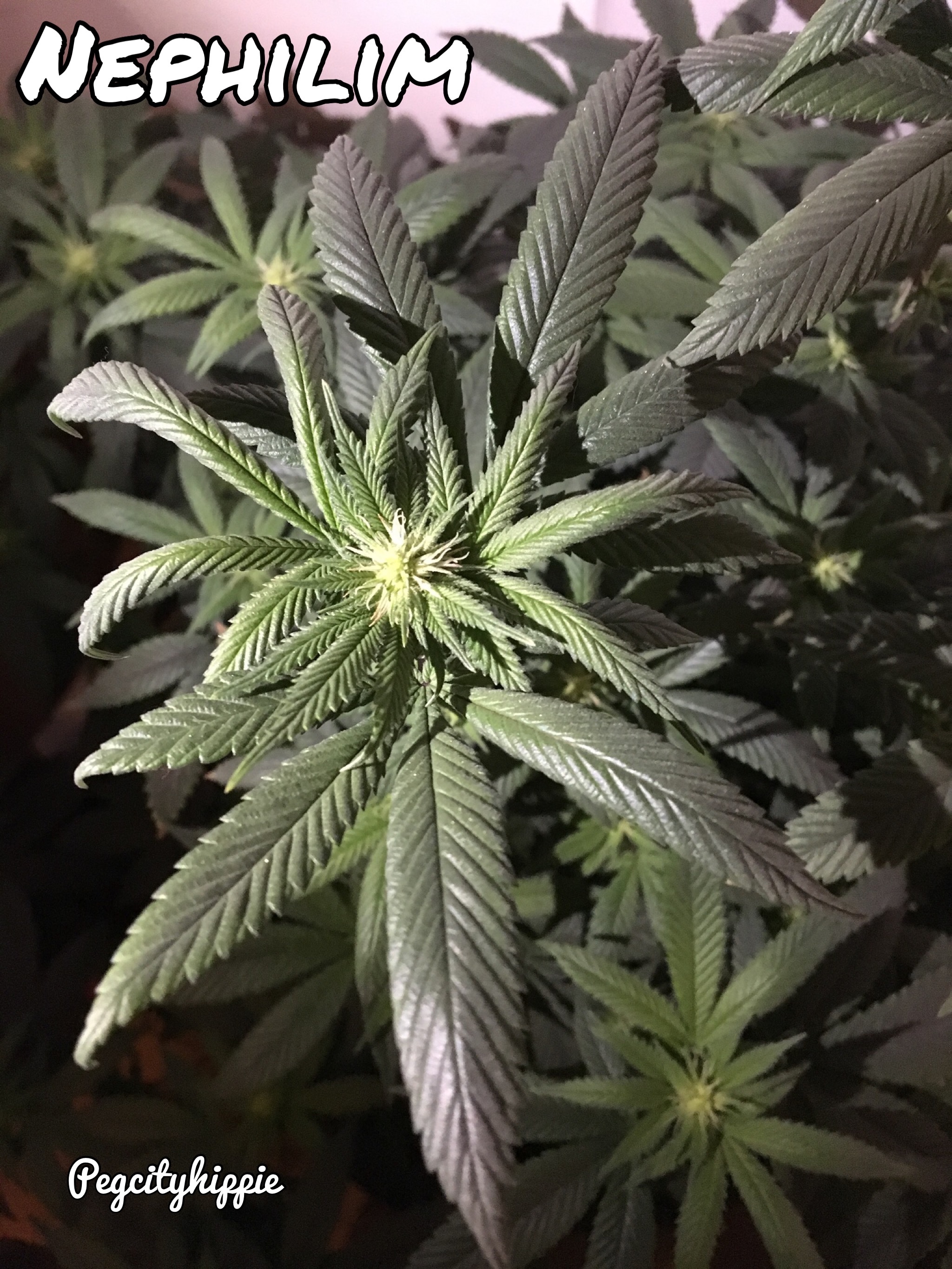
Meet sports fan, enthusiast of videography, photography, music and toons ;), also an activist/advocate born & raised in Winnipeg, and one of Manitoba’s faces of Cannabis, Brittany Maydaniuk.
Brittany has smoked cannabis recreationally for years but started using cannabis as medicine in 2014. Brittany was diagnosed with Photosensitive Epilepsy at the age 15 after having suffered minor brain injury from multiple concussions from being bullied in her teens. She endured her first concussion when she was just 12 years old and later experienced her first seizure at age 14. This was a life changing adjustment as Brittany had to learn that flashing lights would trigger her seizures. Attending events, sports games and concerts was a challenge as she has had to close her eyes if there were flashing lights. The numerous pharmaceutical medications that were prescribed only reduced her seizures but never completely stopped them. The medications also had unpleasant side effects such as weight gain, hair loss, problems concentrating, dizziness and fatigue. In January of 2014, Brittany increased her cannabis use to help with insomnia that she was experiencing during night shift employment. Brittany noticed after increasing her cannabis use that her seizures were reduced. In July, after spending a week at Health Science Center, being monitored and tested for her seizures, no answers were found to help stop her seizures so Brittany did her own extensive research and discovered CBD as a treatment. In September of that year, Brittany experimented with daily cannabis use and eventually became a licensed patient under the MMPR program. She remained seizure free until May 2018.
Like most other cannabis users, and my own personal experience, it has often been noted that when one uses the cannabis plant to treat a certain symptom of a disease or disorder is that it is found that it helps with other symptoms of that or other diseases or disorders that weren’t always expected.
Brittany reported that “Cannabis didn’t just help my epilepsy, it also helps my Osteoarthritis in my knee and lower back, Spondylitis, IBS, Chronic Insomnia, Depression among other things.
Cannabis gave me my life back. It has greatly improved my quality of life.
Today Brittany is able to work full time whereas before she wasn’t able to maintain a job because after suffering a seizure she would need 2-3 days to recover.
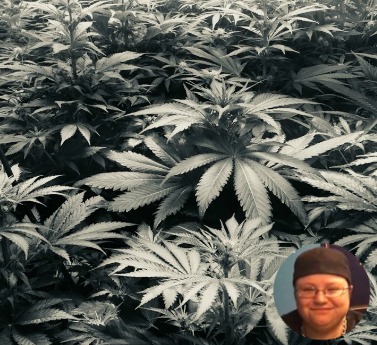 Brittany was looking forward to getting her drivers licence after being seizure free for over 3 1/2 years but after suffering a seizure last week she will have to wait until she is seizure free for at least a year.
Brittany was looking forward to getting her drivers licence after being seizure free for over 3 1/2 years but after suffering a seizure last week she will have to wait until she is seizure free for at least a year.
Despite all, Brittany faces life with a positive attitude and a smile on her face. Brittany has a gained love for animals. Her care and love for animals emerged during a time when her mom obtained an excess animal permit allowing them to care for animals in need, cats, dogs and even hedgehogs.
Positive vibes, positive mind, positive life!!!
 All Human Beings have an EndoCannabinoid System. Since it’s discovery, it has also been found that this system is also implicated in ALL human diseases and disorders. It is a novel endogenous signalling system that is involved in many, many functions of physiological and pathological conditions. It is equipped with cannabinoid receptors Type 1 (CB1) and Type2 (CB2) throughout the body, their endogenous fatty-acid ligands (endogenous cannabinoids or endocannabinoids, ECs), and the proteins responsible for EC biosynthesis and degradation. At this point in time sadly, only 20% of cannabis research approved by the federal government is actually even looking at therapeutic use. Eighty percent of it is wasted still looking at cannabis abuse and addiction. Funding for research is also severely restricted; only 16% of federal funding for cannabis research goes to exploring therapeutic use. Yet no other plant seems to be able to treat so many symptoms, calm/quiet so many conditions and provide that homeostasis which our bodies require.
All Human Beings have an EndoCannabinoid System. Since it’s discovery, it has also been found that this system is also implicated in ALL human diseases and disorders. It is a novel endogenous signalling system that is involved in many, many functions of physiological and pathological conditions. It is equipped with cannabinoid receptors Type 1 (CB1) and Type2 (CB2) throughout the body, their endogenous fatty-acid ligands (endogenous cannabinoids or endocannabinoids, ECs), and the proteins responsible for EC biosynthesis and degradation. At this point in time sadly, only 20% of cannabis research approved by the federal government is actually even looking at therapeutic use. Eighty percent of it is wasted still looking at cannabis abuse and addiction. Funding for research is also severely restricted; only 16% of federal funding for cannabis research goes to exploring therapeutic use. Yet no other plant seems to be able to treat so many symptoms, calm/quiet so many conditions and provide that homeostasis which our bodies require.
Cannabinoid-based medications provide not only relief for specific symptoms, but also have been found to help in the arrest or delay of disease progression in many patients.
Epilepsy, Osteoarthritis, Spondylitis, IBS, Chronic Insomnia and Depression…
“Cannabis has been associated with the treatment of epilepsy throughout history, and if ancient Assyrian sources referring to “hand of ghost” are considered credible, this relationship may span four millennia. A tradition of usage continued in Arabic medicine and Ayurvedic practice in India, which led, in turn, to early experiments in Europe and North America with “Indian hemp.” Lack of standardization, bioavailability issues, and ultimately prohibition were all factors in cannabis-based medicines failing to maintain mainstream usage in seizure treatment, but investigation was resumed in the 1970s with interesting signals noted in both laboratory and clinical settings. Early case studies showed promise, but lacked sufficient rigor. Resumption of research coupled with mass experimentation by families of epilepsy patients has led to intense interest in cannabis-based medicines for its treatment once more, with greatest focus on cannabidiol, but additional investigation of tetrahydrocannabinol, tetrahydrocannabinolic acid, and other phytocannabinoids.”
Epilepsy, which involves a broad spectrum of disorders that affect about 50 million people in the world. Epilepsy is one of the world’s oldest recognized and prevalent neurological diseases. It has a great negative impact on patients’ quality of life. Although at present we have over 20 different types of drugs for epilepsy, 30 to 40% of patients continue to have seizures and despite the introduction of new antiepileptic drugs (AEDs), the quality of life and therapeutic response for patients with epilepsy remains still poor. Unfortunately, besides several advantages, these new AEDs have not satisfactorily reduced the number of refractory patients. Therefore, the need for different other therapeutic options to manage epilepsy is still a current issue. To this purpose, emphasis has been given to phytocannabinoids, which have been medicinally used since ancient time in the treatment of neurological disorders including epilepsy” Preliminary data from human studies suggest that cannabis, cannabidiol in particular, is effective in the treatment of some patients with epilepsy.” “There is indeed sufficient supporting data for clinical development and important antiepileptic effects and the currently ongoing clinical studies will permit the real usefulness of CBD and possibly other cannabinoids.” The pharmacologic and biochemical features of cannabinoids make them ideal candidates for antiseizure medications.Cannabinoids not only provide neuroprotection against brain excitability in epilepsy but have anticonvulsant properties too.“Treatment-resistant epilepsy (TRE) affects 30% of epilepsy patients and is associated with severe morbidity and increased mortality. Cannabis-based therapies have been used to treat epilepsy for millennia, but only in the last few years have we begun to collect data from adequately powered placebo-controlled, randomized trials (RCTs) with cannabidiol (CBD), a cannabis derivative.” Clinical evidence seems to indicate that CBD is able to manage epilepsy both in adults and children affected by refractory seizures, with a favourable side effect profile. There’s a little more than just “potential” for the efficacy of cannabis in treating epilepsy Several anecdotal reports, clinical trials suggest and evidence revealed therein show that in the human population cannabis has anticonvulsant properties and could be effective in treating partial epilepsies and generalized tonic-clonic seizures, still known as “grand mal.” They are based, among other factors, on the observation that in individuals who smoke marijuana to treat epilepsy, cessation of cannabis use precipitates the re-emergence of convulsive seizures, whereas resuming consumption of this psychotropic drug controls epilepsy in a reproducible manner.
“CURRENT EVIDENCE IN HUMANS – The effectiveness of marijuana in the treatment of epilepsy was originally reported as early as 1800 BC. Initial clinical trials in humans using CBD were described during the 1970s, but it was in the 1990s, with the discovery of an endogenous cannabinoid-signalling system, that interest was rekindled in the potential therapeutic effect of cannabis for treating nervous system disorders, including epilepsy.”
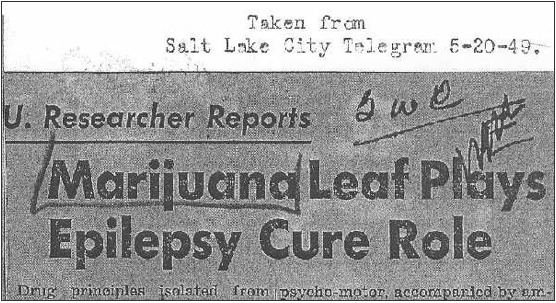
The above newspaper article, taken from the “Salt Lake City telegram [May 20, 1947], was located via the National Archives (College Park, MD). It belonged to and was integrated into the files of Harry Anslinger’s old Bureau of Narcotics, today known as the D.E.A. We believe that it was the first that Anslinger knew about the study, and thus too late to CENSOR or put a stop to it.


Inflammatory pain in spondylitis or Osteoarthritis pain? Currently, with regards to the Inflammatory disease Osteoarthritis, the therapeutic approaches are limited as no drugs are available to control the disease progression and the analgesic treatment has restricted efficacy. Osteoarthritis is a degenerative joint disease associated with cartilage deterioration. The major clinical outcome of osteoarthritis is a complex pain state that includes both nociceptive and neuropathic mechanisms.


Cannabis-based drugs have been shown to be effective in inflammatory diseases. Cannabinoids represent an emerging and innovative pharmacological tool for the treatment of OA.
There is a growing body of scientific evidence which supports the analgesic potential of cannabinoids to treat osteoarthritis pain including early phase inflammation which helps to prevent pain and nerve damage associated with osteoarthritis. Recent pre-clinical evidence supports a role for the ECS to control OA pain.
Studies demonstrated that the Cnr2 pathway plays a role in the pathophysiology of osteoarthritis and also shown that pharmacological activation of CB2 has a protective effect.
Research has confirmed that underlying endocannabinoid deficiencies indeed play a role in irritable bowel syndrome and a growing list of other medical conditions.
Extracts from the cannabis plant have been used to fight against diseases of the gastrointestinal (GI) tract since ancient times/ancient medicine.

The use of cannabis is common in Inflammatory Bowel Disease, and it is proving safe… – “Marijuana use may be higher in patients with IBD symptoms not well treated by conventional medical approaches.”
Accumulating preliminary data from human studies support a beneficial role of cannabinoids in IBD
It’s gonna be one of those days where my coffee is gonna need a coffee.
With Chronic insomnia, cannabis can help you get a goods night sleep. CBD, THC and CBN are the cannabinoids responsible for helping with sleep. Indica strains with relaxing and sedating terpenes such as myrcene and terpinolene can induce heavy sleepy effects. In aged cannabis, THC can be converted to CBN (cannabinol) which is 5X more sedating than THC. Pairing cannabis with other natural sleep aids such as a cup of chamomile tea, a lavender bubble bath, Melatonin, 5-HTP, and valerian root supplements can help improve your sleep by greatly enhancing the sedation efficacy. Cannabis has the ability to subdue stress, help you relax physically, reduce inflammation and alleviate pain and therefore can help you fall asleep faster. Cannabis-infused edibles take longer to take effect than inhalation methods, but their effects can last several hours and help you stay asleep longer.
It’s ironic how exhausting insomnia is.
Depression: Depression is an illness and mood disorder that affects more than 350 million across the world, which is 5% of the world’s population. Many people self-medicate depression symptoms with cannabis. Cannabinoids THC and CBD and terpenes Caryophyllene and Limonene have been found to have an effect on mood, both having antidepressant effects.
The Endocannabinoid System (ECS) related to CB1 receptors is involved in human emotion regulation, especially depression occurrence. Indeed, CB1 receptors are all distributed in depression associated neuroanatomical structures and neural circuits. Clinical studies have demonstrated that impairment of the ECS pathway is present in depression models. The ECS has an important function in both depression treatment and the effects of antidepressants.
Antidepressant-like effect of Δ9-tetrahydrocannabinol and other cannabinoids isolated from Cannabis sativa L
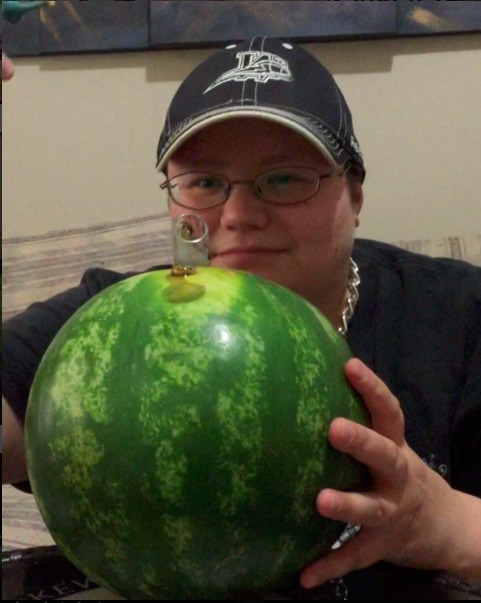 The antidepressant action of cannabis as well as the interaction between antidepressants and the endocannabinoid system has been reported….cannabichromene (CBC) and cannabidiol (CBD) exhibited significant effect at 20 and 200 mg/kg. The antidepressant-like action of Δ9-THC and CBC has been further confirmed. Δ9 -THC exhibited the same U-shaped dose response with significant antidepressant-like action at 2.5 mg/kg while CBC resulted in a significant dose dependent decrease in immobility at 40 and 80 mg/kg doses (p < 0.01). Results of studies have shown that Δ9-THC and other cannabinoids exert antidepressant-like actions, and thus may contribute to the overall mood-elevating properties of cannabis. In addition to the established effects of cannabis, it is well recognized that mood elevation is one of the components of the complex experience elicited by cannabis (Skolnick et al., 2001). Most knowledge regarding cannabis effect on mood and anxiety is based on individual reports following cannabis use for medicinal or recreational purposes. Several anecdotal reports also describe the antidepressant effect of cannabis, with patients confirming beneficial outcomes from its use in primary or secondary depressive disorder.
The antidepressant action of cannabis as well as the interaction between antidepressants and the endocannabinoid system has been reported….cannabichromene (CBC) and cannabidiol (CBD) exhibited significant effect at 20 and 200 mg/kg. The antidepressant-like action of Δ9-THC and CBC has been further confirmed. Δ9 -THC exhibited the same U-shaped dose response with significant antidepressant-like action at 2.5 mg/kg while CBC resulted in a significant dose dependent decrease in immobility at 40 and 80 mg/kg doses (p < 0.01). Results of studies have shown that Δ9-THC and other cannabinoids exert antidepressant-like actions, and thus may contribute to the overall mood-elevating properties of cannabis. In addition to the established effects of cannabis, it is well recognized that mood elevation is one of the components of the complex experience elicited by cannabis (Skolnick et al., 2001). Most knowledge regarding cannabis effect on mood and anxiety is based on individual reports following cannabis use for medicinal or recreational purposes. Several anecdotal reports also describe the antidepressant effect of cannabis, with patients confirming beneficial outcomes from its use in primary or secondary depressive disorder.
Interestingly, the non-psychoactive cannabinoid CBD exhibits a dose dependent antidepressant-like effect also. Unlike Δ9-THC, CBD has low affinity for both CB1 and CB2 receptors.
Results have also concluded that phytocannabinoids, including Δ9-THC, CBD, and CBC, exert antidepressant-like actions in animal models of behavioral despair too. The endocannabinoid system has been proven to be involved in the pathophysiology of depression with most favourable profiles for both CDB and THC.
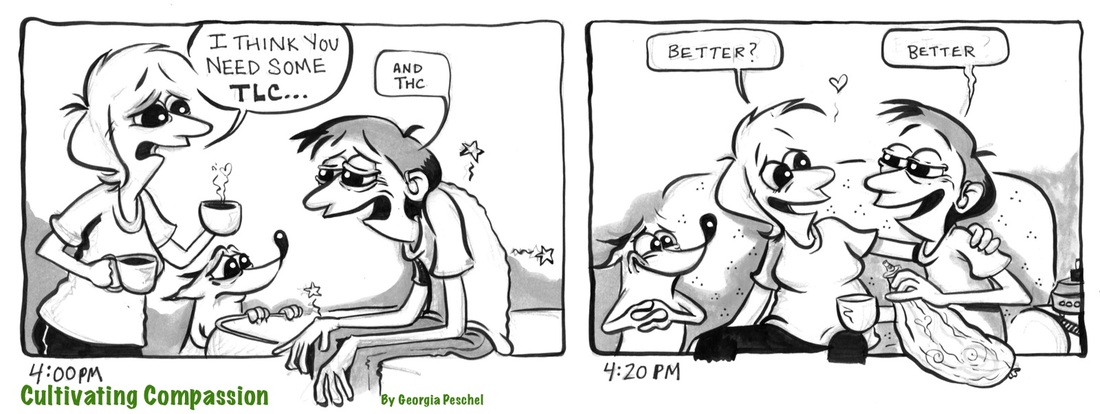
You can find more of Brittany’s photos & videos @Peg City Hippie
I love taking photos and videos and find cannabis to be such a beautiful medium.
Cats & Dabs
DEFICIENT and DYSREGULATED SYSTEMS REQUIRE REPLENISHMENT TO PROPERLY REGULATE AND PROVIDE THE BALANCE OUR BODIES MAY DESPERATELY REQUIRE.
Brittany uses both concentrates and flower and mentions how she finds concentrates allow her to better treat her chronic pain but also desires the significance and effect of the cannabinoid profile you get with flower. Her preference for inhalation delivery methods is dab rigs and bongs, she finds these least harsh on her lungs. She benefits from [m]edibles for a “more restful sleep”. also uses canna-medicated creams for her sore & aching muscles. Vaping & tinctures she finds handy in addition for “on the go use”.
When asked her favourite cultivar she responded “My absolute fav strain is Jack Herer, Lemon Jack if I can get it.” Brittany also uses and reps for Prairie Extracts.
We asked Brittany if she found access to cannabis reasonable and she explained that for her personally, she didn’t have any problem accessing cannabis. However sometimes it can be a struggle to always afford the price of meds. “I am lucky in that I know so many incredible people in the cannabis community.” she says.
So many innocent people needlessly suffer from not having access to reliable, affordable, quality cannabis. This needs to change!
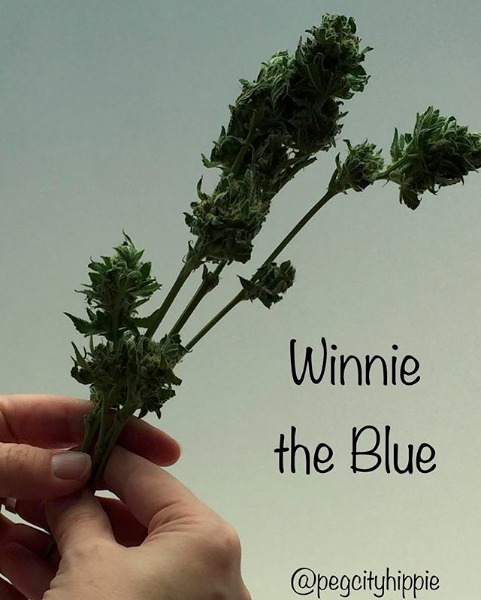
This is one of my favourite photos I’ve taken. I love the bluesh tint in the background coming from the window. It perfectly suits the strain. Winnie The Blue by @greenbeaver420.
The earth would be a much healthier place if we focused on hemp instead fossil fuels and plastics.
With summer around the corner curious to learn what places in Manitoba folks love to be….
If I was to pick my favourite place in Manitoba to visit it would be most likely Riding Mountain. I love camping out there and going on the Bison tour.
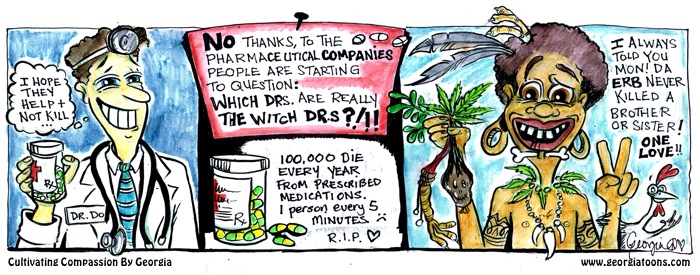
Brittany has expressed that she also could not have survived without the amazing support of her family. They gave both emotional and financial support when her health was at it’s worst. They have also witnessed the miracle of cannabis in action and seen how it improved her quality of life in so many ways. This experience has moved Brittany as an advocate for cannabis both medically and recreationally.
Brittany’s dream is to one day have a job in the cannabis community helping patients discover the many benefits of cannabis. “There are so many people needlessly suffering medically because of stigma, misinformation and lack of access. Legalization can’t get here fast enough!”
You can also find Brittany on Instagram @Peg City Hippie.
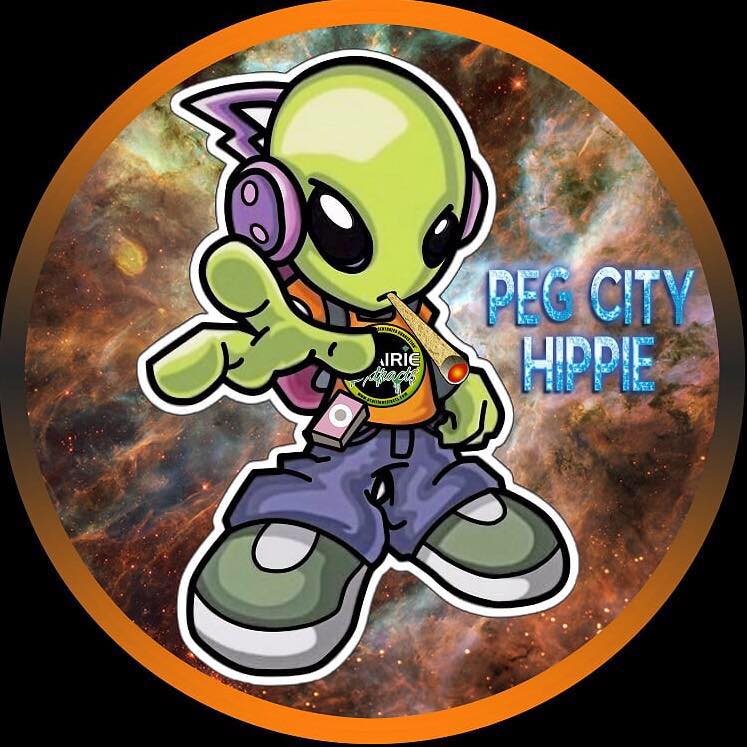
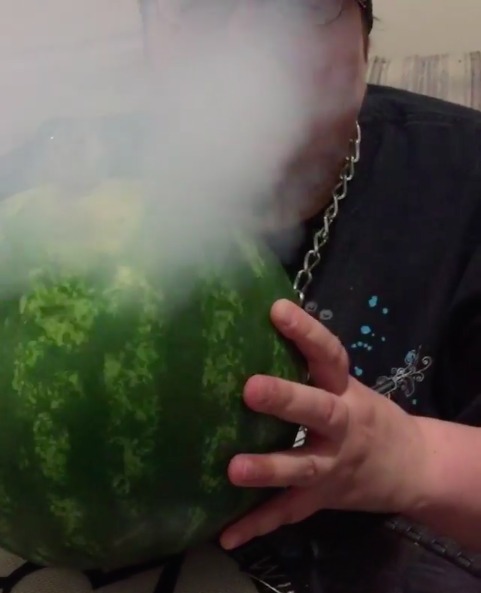
Thank you Brittany for sharing your personal experience with us, living with Epilepsy. We honour your strength, positivity, cool & passionate personality and hope that this blog too can give insight to others.
– OneLove
If you suffer from any conditions mentioned in this CannaBlog, perhaps cannabis could be the help you’re looking for, why not ask your doctor.
– Your Friendly Neighbourhood Freedom Wares Team

Brittany dedicates this CannaBlog to her late mother Christina, who passed away on January 15 this year.
In her honour.
She was very supportive of my cannabis use after witnessing first hand the effect it had on my health. I also got my activism gene from her. RIP Mom. – Brittany
“I have no respect for bullies. The way you treat others says all I need to know about your character. School can be a hard place for some people, especially the teen years. And kids that don’t fit into the majority, the one’s who stick out for whatever reason, can be easy targets. But I do have faith. I see progress and with each generation we get a little bit better, a little more progressive and evolved on issues. Anytime you bring a group of people together certain personalities clash and problems happen. Adults bully too so you can’t just blame children, and besides they’re are just learning social skills, adults should know better. I just want people to realize that bullying DOES have consequences. Mine was Epilepsy.”
Be the change you want to see, make bullying stop.
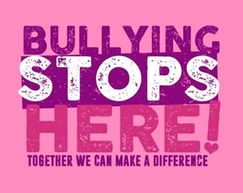 “Manitoba’s Public Schools Act defines bullying as behaviour that is intended to cause, or should be known to cause, fear, intimidation, humiliation, distress or other forms of harm to another person’s body, feelings, self-esteem, reputation or property. It is also behaviour that is intended to create, or should be known to create, a negative school environment for another person. Bullying usually takes place in a context of a real or perceived power imbalance between people involved and is often repetitive behaviour, but does not have to be. Bullying can be direct or indirect, and a person can participate in bullying by intentionally assisting or encouraging bullying behaviour in any way. Bullying can take many forms: verbal, physical, social, or electronic (cyberbullying). It can focus on: disability; sexual orientation; gender identity; sexuality; race/ethnicity/religion; or other issues.
“Manitoba’s Public Schools Act defines bullying as behaviour that is intended to cause, or should be known to cause, fear, intimidation, humiliation, distress or other forms of harm to another person’s body, feelings, self-esteem, reputation or property. It is also behaviour that is intended to create, or should be known to create, a negative school environment for another person. Bullying usually takes place in a context of a real or perceived power imbalance between people involved and is often repetitive behaviour, but does not have to be. Bullying can be direct or indirect, and a person can participate in bullying by intentionally assisting or encouraging bullying behaviour in any way. Bullying can take many forms: verbal, physical, social, or electronic (cyberbullying). It can focus on: disability; sexual orientation; gender identity; sexuality; race/ethnicity/religion; or other issues.
Cyberbullying is defined in the provincial legislation as engaging in the above behaviours through the use of the Internet or other communication technologies, including email, social media or text messages.”


